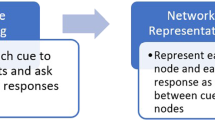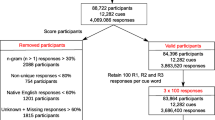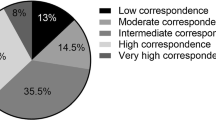Abstract
A word association test was administered to a group of 316 undergraduate students. Word stimuli were balanced according to frequency of occurrence in written English language usage (frequent, infrequent), word length (short, long), abstraction level (low, medium, high), and grammatical class (noun, verb, adjective). Responses were analyzed according to a syntactic classification system. The factorial nature of the word list used enhances its value as a research tool.
Similar content being viewed by others
References
Anderson, B.The psychology experiment. Belmont, California: Brooks/Cole, 1971.
Brown, R., & Berko, J. Word association and the acquisition of grammar.Child Development, 1960,31, 1–14.
Buckingham, B., & Dolch, F.A combined word list. Boston: Ginn, 1936.
Buss, A.Psychopathology. New York: Wiley, 1966.
Clark, E. How children describe time and order. in C. Ferguson & D. Slobin (Eds.),Studies of child language development. New York: Holt, Rinehart & Winston, 1973.
Clark, E. What's in a word? On the child's acquisition of semantics in his first language. In T. Moore (Ed.),Congitive development and the acquisition of language. New York: Academic Press, 1973.
Collins, A., & Loftus, E. A spreading activation theory of Semantic processing.Psychological Review, 1975,82, 407–428.
Darley, F., Sherman, D., & Siegel, G. Scaling of abstract level of single words.Journal of Speech and Hearing Research, 1959,2, 161–167.
Deese, J. Form classes and the determinants of association.Journal of Verbal Learning and Verbal Behavior, 1962,1, 70–84.
Ervin, S. Changes with age in the verbal determinants of word-association.American Journal of Psychology, 1961,74, 361–372.
Gates, A.A reading vocabulary for the primary grades. New York: Columbia University, 1935.
Goldfarb, R., & Halpern, H. Word association of time-altered auditory and visual stimuli in aphasia.Journal of Speech and Hearing Research, 1981,24, 233–246.
Guiliano, V. Analog networks for word association. In D. Norman (Ed.),Memory and attention. New York: Wiley, 1969.
Halpern, H. Effect of stimulus variables on verbal perseveration of dysphasic subjects.Perceptual and Motor Skills, 1965,20, 421–429.
Halpern, H. Effect of stimulus variables on dysphasic verbal errors.Perceptual and Motor Skills, 1965,21, 291–298.
Halpern, H., Darley, F., & Keith, R. The phonemic behavior of aphasic subjects without dysarthria or apraxia of speech.Cortex, 1976,12, 365–372.
Jakobson, R. Aphasia as a linguistic problem. In S. Saporta (Eds.),Psycholinguistics: A book of readings. New York: Holt, Rinehart & Winston, 1961.
Kent, G., & Rosanoff, A. A study of association in insanity.American Journal of Insanity. 1910,67, 37–96.
McNeill, D.The acquisition of language. New York: Harper & Row, 1970.
Norman, D.Memory and attention. New York: Wiley, 1969.
Palermo, D., & Jenkins, J.Word association norms: Grade school through college. Minneapolis: University of Mineesota Press, 1964.
Posner, M., Lewis, J., & Conrad, C. Component processing in reading: A performance analysis, In J. Kavanagh & I. Mattingly (Eds.),Language by ear and by eye. Cambridge, Massachusetts: M.I.T. Press, 1972.
Russell, W., & Jenkins, J.The complete Minnesota norms for responses to 100 words from the Kent-Rosanoff Word Association Test (Tech. Rep. 11, Contract N 8-ONR-66216). Office of Naval Research, University of Minnesota, 1954.
Schlesinger, I. Relational concepts underlying language. In R. Schiefelbusch & L. Lloyd (Eds.),Language perspectives—Acquisition retardation, and intervention. Baltimore: University Park Press, 1974.
Skinner, B. F.Verbal behavior. New York: Appleton-Century Crofts, 1957.
Thorndike, E., & Lorge, I.The teachers wordbook of 30,000 words. New York: Columbia University, 1944.
Vygotsky, L. Thought and speech, 1934. Translated in S. Saporta (Ed.),Psycholinguistics: A book of readings. New York: Holt, Rinehart & Winston, 1961.
Woodrow, L., & Lowell, F. Children's association frequency tables.Psychological monographs No. 97, Vol. 22, 1916.
Author information
Authors and Affiliations
Additional information
The authors wish to thank Professor Louis J. Gerstman, Department of Psychology, City College of CUNY, New York, for his assistance in preparing the statistical data in this study.
Rights and permissions
About this article
Cite this article
Goldfarb, R., Halpern, H. Word association responses in normal adult subjects. J Psycholinguist Res 13, 37–55 (1984). https://doi.org/10.1007/BF01067901
Accepted:
Issue Date:
DOI: https://doi.org/10.1007/BF01067901




